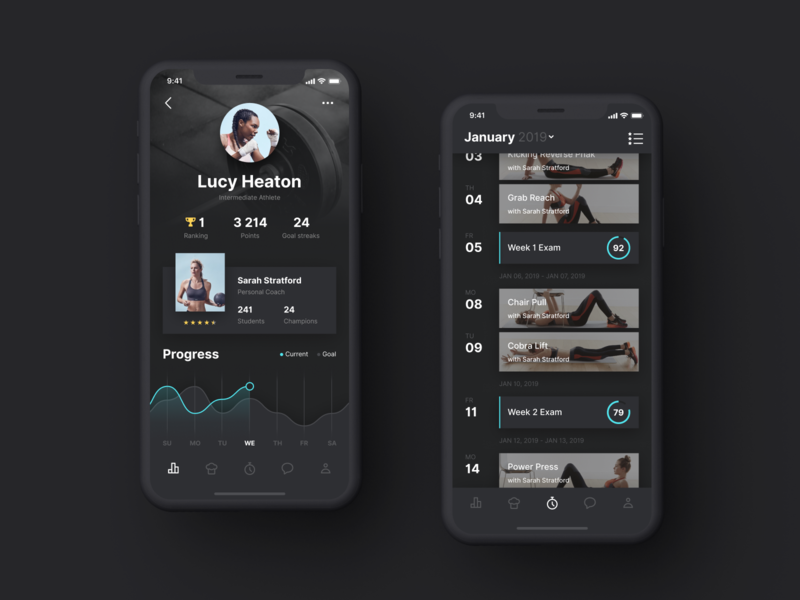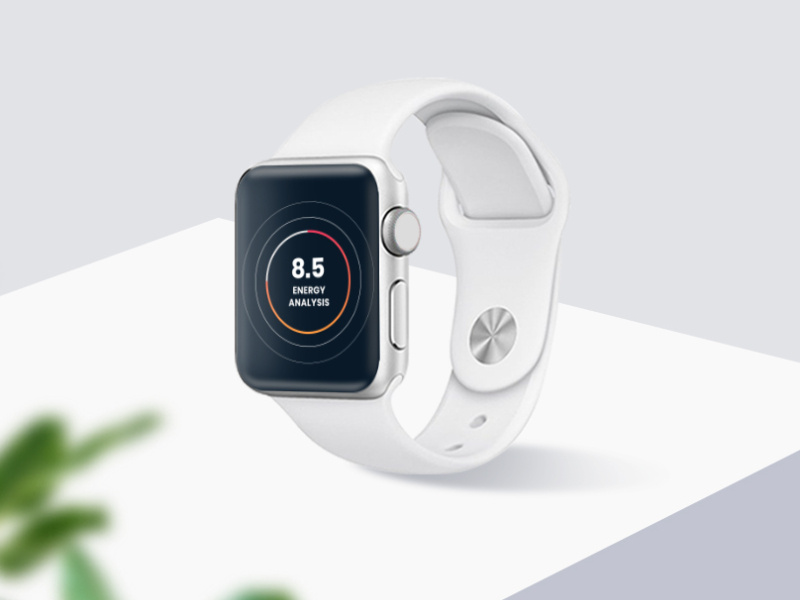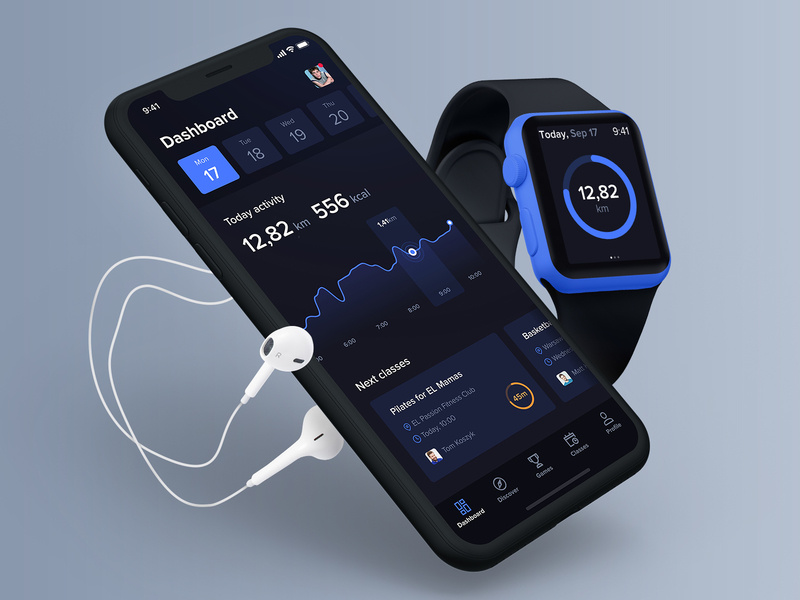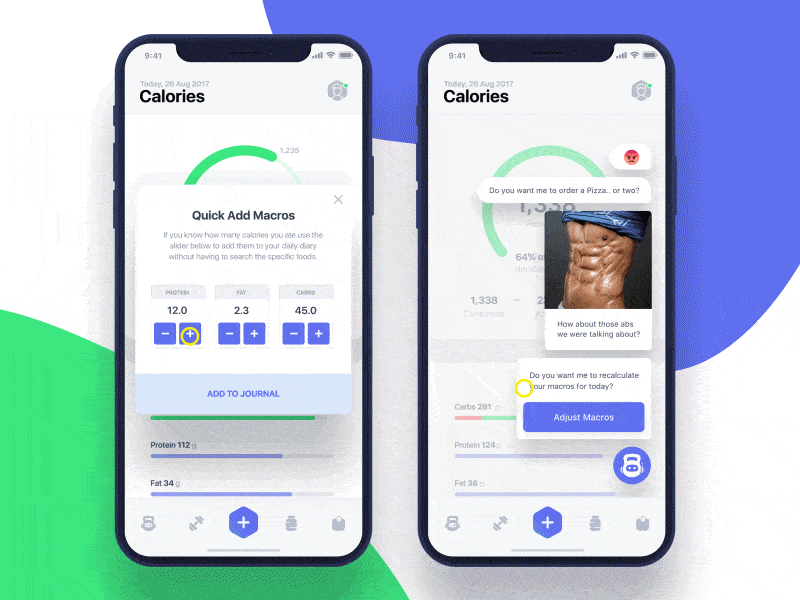The fitness industry is experiencing a steady pattern of growth, whether it’s health clubs or fitness app development companies. Startups are mushrooming up on the intersection of fitness and technology, also known as wellness. Are you planning to create a fitness app? Let’s go through both the essentials and latest technology trends to help you get fitness app development straight.
Contents:
Fitness app development advantages
In the publication by the American College of Sports Medicine (ACSM) on the subject of 2019 fitness trends fitness apps were up at number 13. Brick-and-mortar gyms are having an increasingly harder time to compete against in-app fitness. Technology is transforming the way industry works.
According to Sensortower, revenue from the top 10 health and fitness apps increased by 61% last year to $327 million worldwide. And the number of fitness app users is expected to surpass the figure of 353 million by 2022.
Health and fitness apps also show the highest retention rates across all categories. 96% of users are using only one health and fitness app. This indicates that they are dedicated to their fitness apps once they start using them.
Fitness app development challenges
One of the most important tasks of fitness app developers is protecting the user’s data from being leaked. Pay close attention to the subject of data security.
Another challenge is delivering exceptional user experience for the apps to be fast and easy to use. If you’re not well-experienced in this business, you might find yourself in need of help from the team of UI/UX designers during this stage of fitness application development.
One other obstacle that can curb entrepreneurs’ enthusiasm is the sheer number of such apps on the market – there are thousands. So a great way to find your unique advantage is to be on the edge of innovation and follow what’s trending at the moment.

Fit-In-Turn App Concept by Shakuro
Fitness industry trends reflect global trends in society. Technologies are seamlessly integrated into our lives. They are finding their place in people’s fitness and health routines. The convenience that technology brings to life is beyond compare, and the fitness industry is no exception.
In this article, I picked some of the latest fitness technology trends for you to imagine how they can be useful for your – existing or future – fitness business.
Wearable tech
According to the ACSM publication, wearable technology is the number 1 fitness trend for 2019. And that’s a no-brainer.
Remember the last time you tried exercising holding your phone or even keeping it on you. It’s not very convenient. And swimming with it is even more difficult if not impossible, however waterproof your device might be. Sure, smartphones are capable of counting steps and tracking locations, but they miss some useful functions like heart rate monitoring. While wearables like smartwatches sit comfortably on your wrist and don’t conflict with your activities. They also make it easier to check on the information you need without the necessity of taking out your phone.
Fitness activity monitoring devices were available in consumer-grade electronics since the early 2000s. But they became all the rage in 2008 when Fitbit, Jawbone, and Nike presented activity tracking devices of their design. Since then, various companies have entered the business with fitness bands of their own. After the release of the Apple Watch in 2015, interest in wearable technology went through the roof. It can track steps, workout length, calories burned. It also suggests new goals and reminds you to stand up and take a walk if you’ve remained stationary for too long. Today, the Apple Watch is people’s favorite smartwatch on the market, followed by Samsung and Fitbit.
The wearables market as a whole is building momentum. Statista estimates that the number of wearable devices worldwide is to double from 2019 to 2022. Especially popular are the smartwatches. Shipments are thought to increase by more than 50% from 53 million units in 2018 to 115 million units in 2022. This is more than PCs or even smartphones.

Wearable App Development by Excellent WebWorld
Smartwatches are becoming all about fitness and an important part of today’s sports and health industry.
Whether it’s Apple Watch or a Samsung Galaxy Watch, there are lots of fitness apps out there. And if you want to become part of the growing market and develop your health and fitness app, you should consider their main features, that is:
- connectivity with wearable devices
- providing tracking information like weight, activity, sleep, heart rate and more
- ability to be used as a standalone tracking app.
Your fitness app needs to work well and be compatible with the largest number of wearable devices possible. Even leading wearables manufacturers make their apps to agree with competitors’ fitness trackers. You can say the same about apps. Fitness apps like Strava, RunKeeper, Jawbone Up and MyFitnessPal can deal with the data from the majority of trackers. During health and fitness app development be sure to make your app integrate smoothly with wearable devices. For example, one of the challenges which Shakuro Design and Development Agency had to rise to during making the Fit for Bucks app was the fact that it relies on the integration with wearable devices. And activity trackers produced by different manufacturers have different logic and need custom application sync methods.
There are a lot of special tools that health and fitness app developers can use to integrate them with wearables. Garmin, Fitbit grant tools for integrating with their products. Apple and Google also provide their SDKs for wearables.

FitnessKingdom Dashboard by Jakub Wojnar-Płeszka
Streaming services
My friend Anya started hitting the gym regularly when she was at university. But over the years, boredom gradually set in. Treadmill monotony became the initial reason to start neglecting the gym. Many extra aspects joined in, like mismatched schedules, long working hours, family and social commitments and occasional issues with coaches. “I’m almost ready to give up on working out altogether,” she said to me one day. And the option of finding a personal trainer celebrity-style was too expensive.
And then I thought, what if… Streaming services existed!
Yes, there are online fitness coaching programs out there today. And as the word “online” suggests, they can be done almost entirely online or through an app. Digital trainer apps are taking our lives by storm and it’s hardly surprising.
They are great because they better coincide with your schedule and you’ll never have to worry about meeting a trainer at a time that’s unsuitable for you.
What’s more, you’re able to assess your progress with the help of fitness trackers we discussed earlier. You can see what’s working for you and what’s not. Seeing the hurdles you’ve overcome can serve as an important motivator to help you continue getting fitter. That’s what might prove helpful for Anya.
Sure, digital coaching can’t entirely compare with gyms IRL. You can’t rely on a coach to revise your program, so it can pose some problems for beginners. Another problem is the absence of some of the bulky equipment (if needed). But the thing is, most streaming services offer videos both with and without equipment. There are also classes available that don’t need it, like yoga. By the way, yoga is among the top 10 fitness trends of 2019 too.
For example, Peloton offers live-streamed classes on a daily basis. Yes, they also sell Peloton bikes and treadmills that include a subscription. But you don’t have to buy them to get their content. And a monthly subscription costs less a single class at a fitness studio.
Addicted to the Peloton digital app. I just use a stationary bike that we already had for the spin classes, plus I do the other classes (Stretch, strength, walk/run, etc.). For $20/month when I live in the middle of nowhere? Yes please!
— Nutmeg (@chirish01) October 14, 2019
Artificial intelligence
But what if we forego human coaches altogether?
Artificial Intelligence is no longer something from science-fiction movies. It’s impacting our daily lives. Siri, Alexa, Cortana, and other virtual assistants help us with various tasks, from searching for something on the web to sending commands to other apps.
Artificial intelligence is great for integration with fitness. It can act as a virtual personal trainer who can guide you in maintaining your health and form.
For a long time, fitness fans looking for at-home routines have had to rely on personal trainers. But, again, these trainers aren’t cheap. That’s why a growing number of fitness app development companies are using AI to offer at-home training that is both personalized and comparatively low-cost.
One of the examples is the fitness platform Aaptiv that decided to take a turn and introduced its new AI coach. It’s an AI assistant that sets up personalized fitness plans based on your goals, current fitness level, eating habits with the use of data from wearable devices. Users can sort through recommended exercises, or choose a class based on their mood at the moment.
Boltt Sports Technologies, Hacarus, Ensa, Robotbase among others develop artificial intelligence-based personal assistants. They claim that their innovations aim at bringing an improved experience to fitness enthusiasts.
And tomorrow’s AIs will make even more humanistic conversations and communications, which will be welcome by users. According to Gartner Inc., by 2020 up to 25% of customer service operations will be made with the help of virtual customer assistants.

Fitness Ai app UI UX by Virgil Pana
Virtual and augmented reality
Remember Back to the Future III joke about running? When Doc tries to tell a group of men in 1885 saloon about life in the future, including their funny exchange about running “for fun”? Well, today in 2019 we can definitely say that running can be real fun with the help of virtual reality tech.
I even think that augmenting fitness programs is one of the best uses for VR possible. Sure, playing action video games enhances your reflexes and improves manual dexterity. But what about playing a game and giving yourself a full-body workout?
Whether it is a full-body setup or just your headset and some controllers, there is plenty of VR tech that can get you moving and give you a workout.
Runtastic uses the Oculus Rift headset to create virtual environments, where trainers perform each exercise and participants follow along. YUR lets you track your calories while using certain games or workouts devices. YUR.fit app for Oculus Quest can turn any videogame on the headset into a fitness experience, tracking the calories on any app. Gamification makes fitness more fun and effective, and according to VRFocus, YUR raised $1 million toward its business ventures.
Are you ready for VR fitness? pic.twitter.com/P96PlyFqEW
— Dr. Kash Sirinanda (@kashthefuturist) October 12, 2019
Now let’s look at how augmented reality can prove useful for fitness.
This year, six years after Google first introduced Google Glass, they presented its newest upgraded version of Glass. You might remember the whole thing as a 2013 flop, but, actually, plenty of other AR devices have been moving recently into the business too, from Microsoft HoloLens 2 to Vuzix’ glasses.
For example, the Kopin SOLOS glasses are specially designed for sports enthusiasts like cyclists and runners to gauge their performance like elapsed time, speed, power, and heart rate. It’ll also work with existing fitness apps like Strava.

AR application for runners by NIX
In conclusion
Being in the know with the current trends in fitness technology will help to give your fitness app a competitive advantage. The market is growing with every passing day.
However, be careful not to put all your eggs in one basket. The thing with technology is that however promising it might be, it’s all about the future and the future is ultimately unpredictable. New tech may not immediately become profitable as Google Glass case has shown. But with the help of the right tools and hardware, the payoff is so much worth it, with increased client rates, better outcomes for consumers, and more financial success for you.
Nothing illustrates it better than the success story of the number 1 health and fitness app in Europe – Freeletics. In its beginnings, in 2014, it was a humble bootstrapped venture founded by a team with no tech background. Today it’s an AI-based service with over 20 million global users. Freeletics company earned $400k in estimated monthly revenue and its app was downloaded 200k times in September 2019.
